ORIC® 20 mm Linear Translation Stages with Piezoelectric Inertia Drive
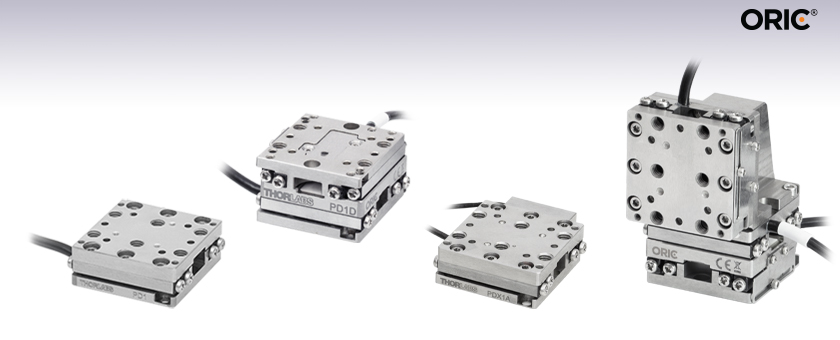
- Linear Stages with Open- or Closed-Loop Positioning
- 3 kg Horizontal Load Capacity
- Stackable Design for Compact 1-, 2-, or 3-Axis Setups
PD1
Piezo Inertia Stage
Application Idea
PD1D and PD1 Stages
in an XYZ Configuration
PDX1A
Low-Profile Piezo Inertia Stage
with Optical Encoder
PD1D
Monolithic 2-Axis
Piezo Inertia Stage
U.S. Patent 11,606,045

Please Wait
| ORIC® Piezo Stage Selection Guide |
|---|
| 4.5 mm Piezo Inertia Vertical Translation Stage |
| 5 mm Piezo Inertia Linear Translation Stages |
| 12 mm Piezo Inertia Linear Translation Stages |
| 20 mm Piezo Inertia Linear Translation Stages |
| 20 mm Ultrasonic Piezo Linear Translation Stages |
| 50 mm Piezo Inertia Linear Translation Stages |
| Piezo Inertia Rotation Stages |
| Piezo Inertia Vacuum-Compatible Stages |
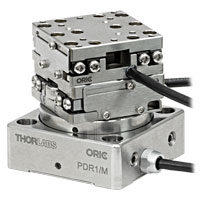
Click to Enlarge
Figure 1.3 XY + rotation stage created by mounting two PD1(/M) linear stages on a PDR1(/M) rotation stage using the included accessories.
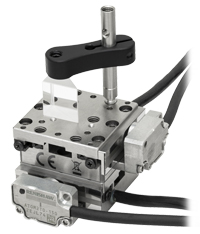
Click to Enlarge
Figure 1.2 A right-angle prism mounted on PDX1 stages in XY configuration using a PM3 clamping arm.
Features
- Compact Stainless Steel Stages with Piezo Inertia Drives
- Ideal for OEMs and Set-and-Hold Applications that Require Relative Positioning with High Resolution
- Several Stage Varieties Available (See Table 1.1)
- Top Plate Adapters Provide Alternative Mounting Hole Patterns
- Mounting Adapters Provide Flat Surfaces for Mounting Stages
- Right-Angle Bracket Adapter Allows Vertical Mounting and XYZ Configurations
- Requires a Piezo Inertia Stage Controller (Sold Separately Below)
Thorlabs' ORIC® 20 mm Linear Travel Piezoelectric Inertia Drive Stages (U.S. Patent 11,606,045) provide fast and stable piezo-controlled linear motion in compact packages with no backlash. The piezo inertia drive mechanism of these stages is self-locking when the stage is at rest and no power is supplied to the piezo, making these stages ideal for set-and-hold applications that require nanometer resolution and long-term alignment stability. All stages have a horizontal load capacity of 3 kg.
The PD1(/M) single-axis and PD1D(/M) monolithic XY stages provide open-loop operation, while the PDX1(/M) and PDX1A(/M) single-axis stages feature optical encoders and support open- and closed-loop operation. Vacuum-compatible versions of the PD1(/M) and PDX1A(/M) stages which use flying leads instead of an SMC or D-sub connector, are also available. The PDX1A(/M) and PDX1AV(/M) 20 mm stages are lower-profile formats of the PDX1(/M) stages with the same mounting features, but with different performance specifications, such as accuracy and minimum step size; see the Specs tab for more details.
Load Mounting Options
The load can be secured to the stage's moving platform using 2-56 (M2 x 0.4) threaded holes or 8-32 (M4 x 0.7) threaded holes. The PD1D(/M) XY stage also offers #2 (M2) and #8 (M4) counterbores for mounting. Alternatively, the PD1T(/M) and PD1U(/M) adapter plates (sold separately below) provide alternative mounting hole patterns for the top plate of the stage. The load can also be aligned using the array of Ø2 mm, 1.5 mm deep dowel pin holes; see the drawings below for details. Thorlabs also offers replacement dowel pins in packs of 20 below. Ensure that the maximum insertion depth of these holes is not exceeded or else the stage may be damaged. For more information, please refer to the Specs tab or the support documents accessible through the red Support Docs icons ![]() )
)
Stage Mounting Options
Counterbores for mounting each stage are accessible when the moving plate is translated to the ends of the travel range. There are two mounting options: two 2-56 (M2 x 0.4) screws on the corners with 0.35 N·m recommended torque or
8-32 (M4 x 0.7) screws along opposing edges of the base with 0.55 N·m recommended torque. We offer the TD75 torque driver for tightening to a specific torque value.
The stages should be mounted on an even surface with a recommended flatness of ≤5 μm. If the stage is mounted on a surface with >5 µm flatness (as with most breadboards and optical tables), the mounting torque may need to be decreased in order for the velocity variation and pitch/yaw of the stage to meet specifications. If needed, the PD1B(/M), PD1B2(/M), and PD1B3(/M) mounting adapters provide a mounting surface with precise flatness to avoid warping the stage when mounting it to a table surface.
Two linear stages can be stacked on top of each other for an XY configuration for applications that require additional movement; an example is shown in Figure 1.2.
The PD1Z(/M) right-angle bracket adapter allows one single-axis stage to be mounted vertically on top of another stage for an XZ or XYZ configuration. Alternatively, the bracket and single-axis stage can be used with a PD1B(/M), PD1B2(/M) or PD3B(/M) adapter for a Z-configuration that can be directly mounted to an optical table or breadboard. Note that when the stage is mounted vertically, the load capacity is greatly reduced.
When the XPCM1(/M) mount is used in combination with a PD1(/M) stage and PD1FM Ø1" Optic Mount, the PD1(/M) stage can be used to provide z- or x-translation of an optic vertically centered within a 30 mm cage system.
Compatibility with Other ORIC Stages
These stages can be combined with an ORIC rotation stage for applications that require XY translation and rotation, an example of which is shown in Figure 1.3. An XZ or XYZ configuration can be created by mounting an ORIC 20 mm linear stage onto the top platform of a PDXZ1(/M) piezo inertia stage with 4.5 mm of vertical motion. ORIC 20 mm linear stages can also be mounted on one of our ORIC 50 mm linear stages where greater travel range is necessary.
Required Controller
One of our piezo inertia controllers is required to operate these stages. Note that the piezo inertia drives cannot be driven using a standard piezo controller. Please see below for more information on which controllers are compatible with each stage.
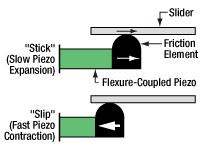
Click to Enlarge
Figure 1.4 Simplified Illustration Showing the Operation of the Piezo Inertia Drive
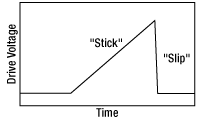
Figure 1.5 The "stick-slip" cycle consists of a slow piezo expansion and a fast piezo contraction.
Piezoelectric Inertia "Stick-Slip" Motor
The piezo inertia motor consists of three main parts: a flexure-coupled piezo actuator, a friction element, and a slider (the moving platform). During the "stick" part of a cycle, the piezo slowly expands under the ramp voltage, pushing the friction element and the slider forward in unison. During the "slip" part, the drive voltage drops rapidly and the piezo element returns to its starting length, with the friction element "slipping" backward. The slider does not move due to its inertia and the low coefficient of kinetic friction between the friction element and the bottom surface of the slider. Figure 1.5 shows the piezo drive voltage during one "stick-slip" cycle.
Repeating this cycle produces continuous forward travel of the slider. For travel in the reverse direction, the opposite drive voltage pattern is required, resulting in rapid piezo expansion and slower piezo contraction, or "slip-stick". During operation, the stage makes a high pitch noise and may generate some heat. This is normal behavior in the performance of the device and does not indicate a fault condition.
Due to a number of factors that include the application conditions, piezo hysteresis, component variance, and the axial load, the achieved step size will vary and is not repeatable. To help overcome this variance, an external feedback system will be necessary.
| Specifications | |||
|---|---|---|---|
| Item # | PD1(/M)a | PD1V(/M)a | PD1D(/M)a |
| Stage Type | Single-Axis Stage with Open-Loop Piezos | Vacuum-Compatible Single-Axis Stage with Open-Loop Piezos |
Dual-Axis Stage with Open-Loop Piezos |
| Travel | 20.0 mm | 20.0 mm x 20.0 mm | |
| Step Size | Typical: 1 µmb Maximum: <3 µmc |
||
| Step Size Adjustability | ≤30%c | ||
| Maximum Step Frequency | 2 kHzd | ||
| Speed (Continuous Stepping) | 3 mm/s Typical Maxe,f | ||
| Average Velocity Variation Over Travel Range |
±10%e,g | ||
| Horizontal Load Capacity | 3 kg (6.6 lbs) | ||
| Vertical Load Capacityh | 100 g (3.5 oz) | 100 g (3.5 oz)i | |
| Clamping / Holding Force | 3 N | ||
| Pitch / Yaw Over Travel Range | 200 µrad | ||
| XY Stacked Orthogonality | <5 mrad | ≤2 mrad | |
| Motor Type | Piezoelectric Inertia Drive | ||
| Lifetime | >10 Billion Stepsj | >10 Billion Stepsj,k | >10 Billion Stepsi,j,l |
| Vacuum Compatibility | N/A | 10-6 Torr | N/A |
| Piezo Specifications | |||
| Max Operating Voltage | 125 V | ||
| Capacitance | 170 nF | ||
| Physical Specifications | |||
| Operating Temperature | 10 to 40 °C | ||
| Connector Type | SMC Female | Flying Leads Attached to Stage; Additional Bare Lead-to-SMC Female Cable Included |
SMC Female |
| Cable Length | 1 m (3.3 ft)m | 0.75 m (2.48 ft) Flying Lead for Vacuum; 1.0 m (3.3 ft)r Cored Cable for Wiring Outside Chamber |
1 m (3.3 ft)m |
| Top Plate Mounting Options |
Four 2-56 (M2) Threaded Holes, 3.5 mm Deep Six 8-32 (M4) Threaded Holes, 3.2 mm Deep Six Ø2 mm Dowel Pin Holes, 1.5 mm Deep PD1T(/M) and PD1U(/M) Adapters |
Four 2-56 (M2) Threaded Holes, 3 mm Deep Two #2 (M2) Counterbores Four 8-32 (M4) Threaded Holes, 3.2 mm Deep Two #8 (M4) Counterbores Four Ø2 mm Dowel Pin Holes, 1.5 mm Deep PD1T(/M) and PD1U(/M) Adapters |
|
| Dimensions | 32.5 mm x 32.0 mm x 11.5 mm (1.28" x 1.26" x 0.45") |
32.5 mm x 32.5 mm x 20.0 mm (1.28" x 1.28" x 0.79") |
|
| Weight (Including Cable) | 76 g (2.68 oz) | 80 g (2.82 oz) | 137 g (4.83 oz) |
| Required Controller (Sold Separately Below) |
KIM001, KIM101o, PDXCp, or PDXC2p,q | ||
| Extension Cable(s) |
PAA101 Cable(s) and T5026 Adapter(s)m | - | PAA101 Cable(s) and T5026 Adapter(s)m |
| Specifications | |||
|---|---|---|---|
| Item # | PDX1(/M)a | PDX1A(/M)a,b | PDX1AV(/M)a,b |
| Stage Type | Single-Axis Stage with Closed-Loop Piezos | Single-Axis Stage with Closed-Loop Piezos | |
| Travel | 20.0 mm | ||
| Optical Encoder Resolution | 10 nm | 12.5 nm | |
| Bidirectional Repeatability | ±0.75 µm | ||
| Absolute Accuracy | ±3 µm | ±2.5 µm | |
| Minimum Incremental Motion | 50 nmc | 300 nmc | |
| Step Size Adjustability | Range Using PDXC Controller Only: 0.01 to 10.00 mmd Range Using PDXC or PDXC2 with PC Control: 10 nm to 10.00 mmd |
||
| Settling Time (Typical) | 300 ms | 400 ms | |
| Maximum Step Frequency | 20 kHz | ||
| Speed (Continuous Stepping) | 2 to 20 mm/s Typicalc | 10 mm/s Typical Maxc | |
| Average Velocity Variation Over Travel Range |
±2%c | ||
| Horizontal Load Capacity | 3 kg (6.6 lbs) | ||
| Vertical Load Capacitye | 100 g (3.5 oz) | ||
| Clamping / Holding Force | 3 N | 4 N | |
| Pitch / Yaw Over Travel Range | 200 µrad | ||
| XY Stacked Orthogonality | <5 mrad | ||
| Motor Type | Piezoelectric Inertia Drive | ||
| Lifetime | ≥25 kmf | ≥25 kmg | ≥25 kmg,h |
| Vacuum Compatibility | N/A | N/A | 10-6 Torr |
| Piezo Specifications | |||
| Max Operating Voltage | 60 V | ||
| Capacitance | 65 nF | 170 nF | |
| Physical Specifications | |||
| Operating Temperature | 10 to 40 °C | ||
| Connector Type | D-SUB 15-Pin Female | Flying Leads; Additional Bare Lead to D-SUB 15-Pin Female Included |
|
| Cable Length | 1.5 m (4.9 ft)i | 1.0 m (3.3 ft) Vacuum-Compatible Flying Encoder Lead 1.0 m (3.3 ft) Vacuum-Compatible Flying Lead 1.0 m (3.3 ft) Cable for Wiring Outside Chamberj |
|
| Top Plate Mounting Options |
Four 2-56 (M2) Threaded Holes, 3.5 mm Deep Six 8-32 (M4) Threaded Holes, 3.2 mm Deep Six Ø2 mm Dowel Pin Holes, 1.5 mm Deep PD1T(/M) and PD1U(/M) Adapters |
||
| Dimensions | 41.6 mm x 32.5 mm x 15.0 mm (1.64" x 1.28" x 0.59") |
36.7 mm x 32.5 mm x 11.5 mm (1.44" x 1.28" x 0.45") |
|
| Weight (Including Cable) | 210 g (7.41 oz) | 110 g (3.88 oz) | 100 g (3.53 oz) |
| Required Controller (Sold Separately Below) |
PDXC or PDXC2 | ||
| Extension Cable(s) |
PDXCE Cable (Optional, Not Included): 3 m (9.8 ft)i | PDXCE Cable (Optional, Not Included): 3 m (9.8 ft)j | |
PD1(/M) & PD1D(/M)
Stages
SMC Female

0 to 125 V
PD1V(/M) Stage
Flying Leads
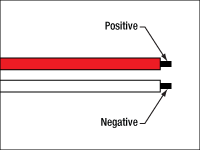
0 to 125 V
PTFE Jacket, 30 AWG
Additional Cable with
Female SMC Connector*

0 to 125 V
*The PD1V(/M) includes an additional bare lead-to-SMC cable.
PDX1(/M) Stage
Female 15-Pin D-Sub
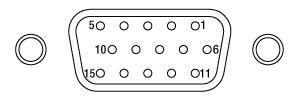
PDX1A(/M) Stage
Female 15-Pin D-Sub

| Pin(s) | Voltage Range | Name | Description |
|---|---|---|---|
| 1 | -7.5 to +12.5 V | Encoder_B_N | Encoder B- |
| 2 | -7.5 to +12.5 V | Encoder_B_P | Encoder B+ |
| 3 | 0 V | GND | Digital Ground |
| 4 | -7.5 to +12.5 V | Encoder_A_N | Encoder A- |
| 5 | -7.5 to +12.5 V | Encoder_A_P | Encoder A+ |
| 6 | - | - | Reserved |
| 7 | - | - | Reserved |
| 8 | +5 V | +5 V | 5 V Power |
| 9 | -7.5 to +12.5 V | Encoder_Z_N | Encoder Z- |
| 10 | -7.5 to +12.5 V | Encoder_Z_P | Encoder Z+ |
| 11 | -10 to +50 V | SigOut2 | Piezo Output 2 |
| 12 | 0 V | PGND | Power Ground |
| 13 | -10 to +50 V | SigOut1 | Piezo Output 1 |
| 14 | 5 V TTL | EEPROM | 1-Wire EEPROM |
| 15 | - | - | Reserved |
| Pin(s) | Voltage Range | Name | Description |
|---|---|---|---|
| 1 | -7.5 to +12.5 V | Encoder_B_N | Encoder B- |
| 2 | -7.5 to +12.5 V | Encoder_B_P | Encoder B+ |
| 3 | 0 V | GND | Digital Ground |
| 4 | -7.5 to +12.5 V | Encoder_A_N | Encoder A- |
| 5 | -7.5 to +12.5 V | Encoder_A_P | Encoder A+ |
| 6 | - | - | Reserved |
| 7 | - | - | Reserved |
| 8 | +5 V | +5 V | 5 V Power |
| 9 | -7.5 to +12.5 V | Encoder_Z_N | Encoder Z- |
| 10 | -7.5 to +12.5 V | Encoder_Z_P | Encoder Z+ |
| 11 | -10 to +50 V | SigOut2 | Piezo Output 2 |
| 12 | 0 V | PGND | Power Ground |
| 13 | -10 to +50 V | SigOut1 | Piezo Output 1 |
| 14 | 5 V TTL | EEPROM | 1-Wire EEPROM |
| 15 | - | - | Reserved |
PDX1AV(/M) Stage
The PD1XAV(/M) stage is supplied with vacuum compatible flying leads for connecting the actuator and the reader to the vacuum chamber bulkhead and an additional cable for connecting to the controller outside the vacuum system. To connect the stage to the controller, first connect the two flying leads from the PDX1AV(/M) stage to the included cable with flying leads on one end and a 15-pin D-SUB female connector on the other. Connect the encoder wires from the stage to the included cable, matching both color and gauge. Then, connect the D-SUB connector to the male terminal on the front panel of the PDXC or PDXC2 controller. For pin-out details, please see the pin diagram and table.
Customers wishing to wire the stage to other systems should consult the colored encoder wire diagram to ensure proper electrical connection. For additional details on the electrical controller connections, please refer to the PDXC or PDXC2 controller manuals.
PDX1AV(/M) Encoder Cable Wire Diagram
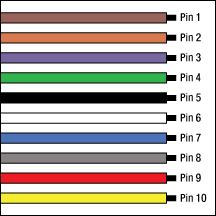
36 AWG
Flying Leads

0 to 60 V
PTFE Jacket, 30 AWG
Female 15-Pin D-Suba

| Pin(s) | Color | Name | Description |
|---|---|---|---|
| 1 | Brown | A_OUT | Encoder A |
| 2 | Orange | B_OUT | Encoder B |
| 3 | Purple | GND | Power Ground |
| 4 | Green | Z_OUT | Encoder Z |
| 5 | Black | GND | Power Ground |
| 6 | White | MA | Controller Clock |
| 7 | Blue | SLI | Device Data In |
| 8 | Grey | SLO | Device Data Out |
| 9 | Red | +5 V | 5 V Power |
| 10 | Yellow | NC | No Connection |
| Pin(s) | Voltage Range | Name | Description |
|---|---|---|---|
| 1 | -7.5 to +12.5 V | Encoder_B_N | Encoder B- |
| 2 | -7.5 to +12.5 V | Encoder_B_P | Encoder B+ |
| 3 | 0 V | GND | Digital Ground |
| 4 | -7.5 to +12.5 V | Encoder_A_N | Encoder A- |
| 5 | -7.5 to +12.5 V | Encoder_A_P | Encoder A+ |
| 6 | - | - | Reserved |
| 7 | - | - | Reserved |
| 8 | +5 V | +5 V | 5 V Power |
| 9 | -7.5 to +12.5 V | Encoder_Z_N | Encoder Z- |
| 10 | -7.5 to +12.5 V | Encoder_Z_P | Encoder Z+ |
| 11 | - | - | Reserved |
| 12 | 0 V | PGND | Power Ground (White Wire) |
| 13 | -10 to +50 V | SigOut1 | Piezo Output (Red Wire) |
| 14 | 5 V TTL | EEPROM | 1-Wire EEPROM |
| 15 | - | - | Reserved |
Software
PDXC Version 2.2.1
The PDXC Software Package, which includes a GUI, drivers, and LabVIEW™/C++/Python SDK for third-party development.
Thorlabs offers the PDXC software package to interface with the PDXC Piezo Stage Controller. This controller is designed to drive the following piezo inertia stages:
- PDXZ1(/M) 4.5 mm Vertical Stage with Optical Encoder
- PD2(/M) 5 mm Linear Stage
- PDX2(/M) 5 mm Linear Stage with Optical Encoder
- PDX4(/M) 12 mm Linear Stage with Optical Encoder
- PD1(/M) 20 mm Linear Stage
- PD1V(/M) Vacuum-Compatible 20 mm Linear Stage
- PD1D(/M) 20 mm Monolithic XY Stage
- PDX1(/M) 20 mm Linear Stage with Optical Encoder
- PDX1A(/M) 20 mm Low-Profile, Linear Stage with Optical Encoder
- PDX1AV(/M) Vacuum-Compatible 20 mm Low-Profile, Linear Stage with Optical Encoder
- PD3(/M) 50 mm Linear Stage
- PDX3(/M) 50 mm Linear Stage with Optical Encoder
- PDX3V(/M) Vacuum-Compatible 50 mm Linear Stage with Optical Encoder
- PDR1C(/M) Rotation Stage
- PDXR1(/M) Rotation Stage with Optical Encoder
The software package allows two methods of usage: graphical user interface (GUI) utilities for direct interaction with and control of the controllers 'out of the box', and a set of programming interfaces for third-party development of custom-integrated positioning and alignment solutions to be easily programmed in the development language of choice (LabVIEW™/C++/Python SDK).
Note: This software is compatible with the PDXC2, KIM001, and KIM101 controllers; it cannot be used to operate the PDXC controller.
Software
Kinesis Version 1.14.58
The Kinesis Software Package, which includes a GUI for control of Thorlabs' Kinesis system controllers.
Also Available:
- Firmware Update Utilities
- Communications Protocol
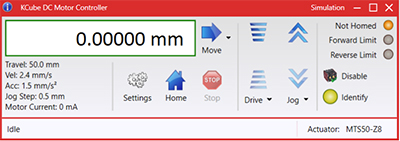
Figure 58A Kinesis GUI Screen
Thorlabs offers the Kinesis software package to drive our wide range of motion controllers. The software can be used to control devices in the Kinesis family, which covers a wide variety of motion controllers ranging from small, low-powered, single-channel drivers (such as the K-Cubes®) to high-power, multi-channel benchtop units and modular 19" rack nanopositioning systems (the MMR60x Rack System).
The Kinesis Software features .NET controls which can be used by 3rd party developers working in the latest C#, Visual Basic, LabVIEW™, or any .NET compatible languages to create custom applications. Low-level DLL libraries are included for applications not expected to use the .NET framework and APIs are included with each install. A Central Sequence Manager supports integration and synchronization of all Thorlabs motion control hardware.
By providing this common software platform, Thorlabs has ensured that users can mix and match any of our motion control devices in a single application, while only having to learn a single set of software tools. In this way, it is perfectly feasible to combine any of the controllers from single-axis to multi-axis systems and control all from a single, PC-based unified software interface.
The software package allows two methods of usage: graphical user interface (GUI) utilities for direct interaction with and control of the controllers 'out of the box', and a set of programming interfaces that allow custom-integrated positioning and alignment solutions to be easily programmed in the development language of choice.
Thorlabs' Kinesis software features new .NET controls which can be used by third-party developers working in the latest C#, Visual Basic, LabVIEW™, or any .NET compatible languages to create custom applications.
C#
This programming language is designed to allow multiple programming paradigms, or languages, to be used, thus allowing for complex problems to be solved in an easy or efficient manner. It encompasses typing, imperative, declarative, functional, generic, object-oriented, and component-oriented programming. By providing functionality with this common software platform, Thorlabs has ensured that users can easily mix and match any of the Kinesis controllers in a single application, while only having to learn a single set of software tools. In this way, it is perfectly feasible to combine any of the controllers from the low-powered, single-axis to the high-powered, multi-axis systems and control all from a single, PC-based unified software interface.
The Kinesis System Software allows two methods of usage: graphical user interface (GUI) utilities for direct interaction and control of the controllers 'out of the box', and a set of programming interfaces that allow custom-integrated positioning and alignment solutions to be easily programmed in the development language of choice.
For a collection of example projects that can be compiled and run to demonstrate the different ways in which developers can build on the Kinesis motion control libraries, click on the links below. Please note that a separate integrated development environment (IDE) (e.g., Microsoft Visual Studio) will be required to execute the Quick Start examples. The C# example projects can be executed using the included .NET controls in the Kinesis software package (see the Kinesis Software tab for details).
 |
Click Here for the Kinesis with C# Quick Start Guide Click Here for C# Example Projects Click Here for Quick Start Device Control Examples |
 |
LabVIEW
LabVIEW can be used to communicate with any Kinesis-based controller via .NET controls. In LabVIEW, you build a user interface, known as a front panel, with a set of tools and objects and then add code using graphical representations of functions to control the front panel objects. The LabVIEW tutorial, provided below, provides some information on using the .NET controls to create control GUIs for Kinesis-driven devices within LabVIEW. It includes an overview with basic information about using controllers in LabVIEW and explains the setup procedure that needs to be completed before using a LabVIEW GUI to operate a device.
 |
Click Here to View the LabVIEW Guide Click Here to View the Kinesis with LabVIEW Overview Page |
 |
Achieving the Specified Performance
In this application note, we will discuss how to achieve the specified velocity and step size for the open-loop PD1(/M), PD1D(/M), and PDR1(/M) ORIC® Stages when driving them with KIM001 or KIM101 K-Cube® Controllers; examples using the Kinesis® software and the K-Cube's front panel controls are discussed below. There are limitations when using an open-loop system, and we have created this application note to help minimize velocity and step size variation. We recommend using this application note upon initial setup, and/or if you are having issues with velocity and step size variation. For further details on how to change settings, please refer to the manuals of the individual stage and controller.
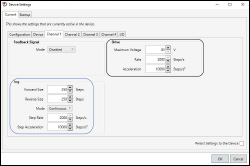
Click to Enlarge
Figure 95B These are the recommended channel settings for the PD(R) stage type. They can be changed in Device Settings -> Current Device Settings-> Channel 1.
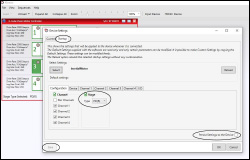
Click to Enlarge
Figure 95A When controlling an ORIC Stage, the stage type needs to be set to PD(R). This can be found in the Kinesis Software Device Settings -> Startup.
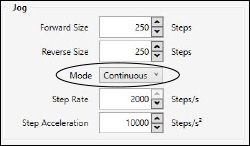
Click to Enlarge
Figure 95D Depicted in the circle is the jog mode, which should be set to continuous. This can be changed in Device Settings -> Current ->

Figure 95C Circled in black are the jog buttons which can be found in the device GUI.
Kinesis© Software Control with a K-Cube Controller
The Kinesis software defaults the stage type to PIA, which is not applicable to ORIC stages; to change this, we need to change the startup settings. The startup settings can be found by first accessing the device settings in the device GUI panel and then clicking the Startup tab. Under the Configuration tab, change the stage type to PD(R), check the "Persist Settings to the Device" box on the bottom right, and click the "Save" button in the lower left corner. These selections are shown circled in Figure 95A. By using these settings, the Kinesis software will use the PD(R) stage type. The other device and channel settings can also be changed in the startup settings.
With the PD(R) stage type, we recommend certain channel settings to achieve the specified speed, speed variation, and force. These settings can be changed in the "Channel 1" tab of the device settings and are depicted in Figure 95B. We will be focusing on the settings in the “Drive” box, circled in black, and the "Jog" box, circled in blue.
For the "Drive" box, we recommend setting the "Maximum Voltage" to 85 V, the "Rate" at 2000 steps/s, and "Acceleration" to 10000 Steps/s2. For the settings in the "Jog" box, we recommend setting the "Forward Size" to 250 Steps, the "Reverse Size" to 250 Steps, the "Mode" to "Continuous", the "Step Rate" to 2000 Steps/s, and the "Step Acceleration" to 10000 Steps/s2. To achieve the specified results, it is important to make sure the stage is mounted properly to an even surface, to our recommended mounting plate, or to a compatible adapter plate.
A continuous jog at a step rate higher than 1000 steps/s can only be achieved by using the jog buttons in the device GUI, shown circled in Figure 95C. Continuous jog movement is limited to within 1000 step/s when using the joystick on the KIM101 K-Cube Controller or wheel on the KIM001 K-Cube Controller. Single movement or movement by counts is not limited to 1000 step/s when using the joystick or wheel.
Please note that if you change the jog mode in Kinesis to "Continuous" or "Single" this will only influence the jog buttons in the Kinesis GUI, shown circled in Figure 95C. This will not change the joystick mode on the KIM001 or KIM101 controller front panel. The jog mode can be found in Kinesis under Device settings -> Channel 1 -> "Jog" box -> "Mode", also shown in Figure 95D. More information on this can be found in the Front Panel Control section, located below.
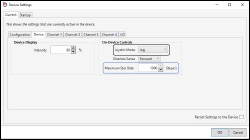
Click to Enlarge
Figure 95F Kinesis software showing the "Device" tab under Device Settings in the Device GUI. The "Maximum Step Rate" setting is circled in blue. To use the joystick with continuous jogging mode this setting must be less than 1000 steps/s. The Kinesis joystick modes can be selected via the dropdown menu circled in black.
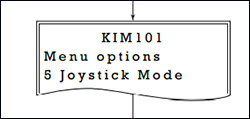
Figure 95E Drawing of the front panel of the KIM101 K-Cube Controller showing option 5, Joystick Mode.
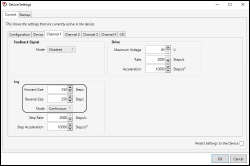
Click to Enlarge
Figure 95H Kinesis software showing where the step size can be changed using the "Forward Size" and "Reverse Size" settings. The "Mode" setting, also shown, only affects the controls of the jog buttons in the GUI and does not affect the joystick mode.

Click to Enlarge
Figure 95G The drive rate can be changed in the Kinesis software under Device Settings -> Current -> Channel 1. This is equivalent to Front Panel Control option 3, "Set Velocity".
KIMx01 Front Panel Control and Related Settings in Kinesis
There are 10 options on the front panel control menu. These can be accessed using the two buttons and joystick on the KIM101 K-Cube Controller or the button and wheel on the KIM001 K-Cube Controller.
Option 5, Joystick Mode, shown in Figure 95E, has 3 modes: "Jog to Count", "Jogging in Steps", and "Velocity Control". The Joystick mode in the Kinesis software is related to option 5, Joystick Mode, on the front panel. The three options for the Joystick Mode in the Kinesis software are "Step Rate", "Jog", and "Goto Position". This setting is circled in black in Figure 95F.
"Jog to Count" mode will move the stage to the target count, which is defaulted at 0, under the velocity that is set by option 3, "Set Velocity" on the front panel. The setting for option 3 is the velocity at which the stage will move for option 5’s “Jog to Count” mode and for option 1, "Goto Pos Count". There is an equivalent setting in Kinesis which can be found in Device Settings -> Channel 1 -> "Drive" box -> "Rate". This is shown in Figure 95G.
In "Jogging in Steps" mode, option 3, "Set Velocity" does not change the stage's velocity. The velocity in this mode must be changed in the Kinesis software. This can be changed in Device settings -> Channel 1 -> "Jog" box -> "Step Rate". Instead of changing the step rate to increase the stage speed, the step size can be changed to increase the stage speed. The step size can be changed on the front panel of a KIM001 or KIM101 device through option 4, "Jog Step Size". This can also be achieved in Kinesis through Device settings -> "Channel 1" -> "Jog" box-> "Forward Size" and "Reverse Size", shown in Figure 95H.
In option 5 "Velocity Control" mode, the joystick can be used to achieve continuous jogging, but only if the velocity is less than 1000 step/s. This velocity cannot be changed by option 3 on the front panel. The velocity can only be changed in the Kinesis software under the Device settings -> Device -> "Maximum Step Rate", shown in Figure 6. A value of 10000 may appear initially, but this value is not accepted by the software and must be revised to a number between 1 and 1000.
In Kinesis, the joystick mode "Step Rate", is related to the "Velocity Control" mode on the front panel and can use the setting of "Maximum Step Rate". The "Direction Sense" can be used to switch the travel direction when using the joystick or wheel.
| Posted Comments: | |
Boris Považay
(posted 2025-09-05 08:08:51.843) How to lock a linear stage after reaching a position against higher on-axis loads? - On-axis forces are specified in the 1N range, but accelerations during shipment etc. might be significantly larger. Is there a recommended locking/clamping mechanism? jdelia
(posted 2025-09-08 07:58:29.0) Thank you for contacting Thorlabs. The locking plate on the side can be used for short term/distance transportation, and its securing force is higher than 1 N (may be several tens of N). We will contact you directly to discuss your application. kx y
(posted 2024-12-05 03:52:33.523) Hi, I'm using PD1/M with KIM101, and the piezo drive voltage is 85V. I'm wondering what is the actual distance of one step? 1um? cdolbashian
(posted 2024-12-11 01:58:07.0) Thank you for contacting Thorlabs. The typical step size of the PD1/M is 1um. This value can vary by up to 20% due to component variance, change of direction, and application conditions. Besides, this value can be adjusted up to about 30% by changing the piezo drive voltage from 85V to 125V. We will reach out to you directly to gather more detailed information about your application. Ioannes Zhang
(posted 2023-08-15 18:28:11.737) Hi, I`m using PD1/M with KIM001 suffering from huge step size difference across opposite directions, too. The motor has no addition load and is fixed on a horizonal PD1B2/M. The problem can be reproduced both via direct control of wheel on KIM001 or via indirect control via Kinesis. I have checked user guides and found that my firmware version is FW1.00.02 (shown in Kinesis), which doesn`t match 010004 as required (in P.13 of PD1 user guide). However, after executing the update utility, the firmware version remain unchanged. I`m wondering whether the failure of controlling comes from outdated firmware. If true, how can I upgrade it. Thank you. cdolbashian
(posted 2023-08-17 08:16:52.0) Thank you for contacting Thorlabs. Due to a number of factors that include the application conditions, piezo hysteresis, component variance, and the axial load, the achieved step size will vary by over 20% and is not repeatable. Before driving this stage, make sure the stage mode is switched to PD(R). We have provided some settings information under "Open-Loop Stage Setup" tab to help minimize velocity and step size variation. The firmware version 010004 refers to the KIM101, so KIM001 does not have such requirements. We have reached out to you directly to troubleshoot this issue. Matt H
(posted 2023-03-28 14:48:21.683) Hi, I am using a PD1D/M and a PD1M in a XYZ config. I have set up using the settings from the Open Loop Tab above. However Like Others I am experiencing big changes in velocity from forwards and Backwards. Whilst the velocity is not an issue the difference in step sizes is huge. In all 3 axes 5000 steps in Forwards direction is almost double 5000 steps in Backwards direction. This means its almost impossible to write software for future automation, as the home position will keep changing every time you move the stage cdolbashian
(posted 2023-04-04 11:05:23.0) Thank you for contacting Thorlabs. Due to open-loop design, component variance and application conditions, the forward and reverse speeds may differ by up to 50%. We recommend to tune speed difference with PDXC’s amplitude adjustment function. As mentioned in "overview" -> "Piezoelectric Inertia 'Stick-Slip' Motor", since the operation of the piezo inertia drive differently in forward and reverse directions, the step size will vary. To help overcome this variance, an external feedback system will be necessary. Jason Hancock
(posted 2023-02-07 07:31:44.88) Hi, I am wondering if you can offer both vacuum compatibility (PDV1) and optical encoder (PDX1) together in the same stage? What exactly is vacuum incompatible about the optical encoder? cdolbashian
(posted 2023-02-17 01:59:17.0) Thank you for contacting Thorlabs. A vacuum compatible PDX1/M is possible. We would first need to do some redesigning and verification of the completed product though. We will reach out to you directly to gather more detailed information about your application, so that we can evaluate the feasibility of the customization. user
(posted 2022-07-27 18:56:40.42) 请问这款位移台的底层驱动资料,我们需要用嵌入式实现驱动程序,包括驱动的协议以及配置和控制的编码要求。 cdolbashian
(posted 2022-08-05 04:43:09.0) Thank you for contacting Thorlabs. The communication protocol is in Chapter 6 of the PDXC manual, and can be downloaded by clicking the red "docs" icon in front of the PDXC part number. (https://www.thorlabs.com/_sd.cfm?fileName=CTN015391-D02.pdf&partNumber=PDXC) edoardo sotgiu
(posted 2022-03-17 13:50:22.75) Hi,
I would like to know if in the near future you could try to provide a service to upgrade the PD1/M to a version similar to the PD1V/M.
Otherwise, as complained by several clients, that stage is really unusable.
Thank you
Regards cdolbashian
(posted 2025-01-30 04:56:01.0) Thank you for reaching out to us with this request. We have contacted you directly in order to assist you with such a upgrade/replacement. Qiyao Liu
(posted 2021-07-21 12:19:56.323) Dear Sir or mdm,
I am looking for a high accuracy translation stage better with nm scale resolution and no backlash. I will use it for scanning, could you please let me know wether this module can realize such function? YLohia
(posted 2021-07-26 11:55:10.0) Thank you for contacting Thorlabs. The PDX1 stage is ideal for applications that require nanometer resolution without backlash. The built-in optical encoder provides high accuracy positioning resolution up to 10 nm when being controlled by the PDXC controller. user
(posted 2021-04-12 15:28:18.773) Hello,
I am experiencing similar issues as some people have already raised in the comments:
1. Speed isnt matching the same displacement forward and backwards. Is there a way to set up the steps to counterbalance this effect ?
2. When placed in a XZ configuration, the Z-module is slicing down. How can i solve this?
3. Out of the 2 PD1/M that i received, one has a loose movable plate and effectively not usable. Is there a bolt to tighten to solve this issue ?
Thank you :) YLohia
(posted 2021-04-14 10:12:22.0) Hello, thank you for contacting Thorlabs. The forward and backward velocities may differ by up to 50% due to the open-loop design, component variances, and application conditions. Operating the stage with the wrong software settings will further increase the variance; be sure to select stage type "PD(R)" in the Kinesis software. To ensure proper performance in the Z axis, please make sure that your load does not exceed 100 g. The loose movable plate is not normal and should not happen with normal use. We may need to take the stage back for inspection and repair. I have reached out to you directly for more troubleshooting. edoardo sotgiu
(posted 2021-03-30 10:33:42.137) Dear Thorlabs,
as experienced by many other users (user (posted 2021-03-10 11:35:33.88), sun fangyuan (posted 2021-03-03 13:28:41.307), Peng Zhu (posted 2020-12-17 13:15:07.46), ...) the speed differs a lot along the two directions (back and fore). In the datasheet is reported that the step size can suffer for a variability of around 20%, but the error here seems even larger (let's say around 50%):
" Due to the open loop design, piezo hysteresis,
component variance, and application conditions, the achieved step size of the system may vary by
over 20% and is not normally repeatable."
Being under warranty, I would like to send you back to verify the stages here are working properly or if they are affected by some weird condition.
Anyway, do you think in the very close future such actuators will be provided with a close loop control? I mean, I would expect an update on the firmware and in case also on the electromechanical components (sensors) on the items we've already bought.
Thank you
Regards nreusch
(posted 2021-04-06 04:12:10.0) Thank you for contacting Thorlabs, we will update some application note on the web about PD1 usage, and in the meanwhile, we will contact you for an inspection of the item. A closed loop version would help and it is something under our new product release plan. user
(posted 2021-03-10 11:35:33.88) Currently using 3x PD1Z and a PDR1 with KIM101 controller. We are experiencing similar issues as mentioned by other users in that the moving speeds differ going forwards and backwards (and up and down).
This is using the native Kinesis (issue also present when using APT) software.
Also found that the "home" command in the provided Kinesis package does not function.
Could you please reach out to resolve this issue? YLohia
(posted 2021-03-15 11:01:53.0) Thank you for contacting Thorlabs. We have reached out to you directly to troubleshoot this further. MICHAEL VALOIS
(posted 2021-03-04 16:36:33.223) I'm having trouble importing the STEP file for your PD1 stage. Could you send a Parasolid or ACIS file?
Thanks,
Mike Valois YLohia
(posted 2021-03-17 02:22:13.0) Hello, thank you for contacting Thorlabs. We will reach out to you directly with a Parasolid file. sun fangyuan
(posted 2021-03-03 13:28:41.307) Hi, when i use the KIM100 (using APT software) to control PD1/M, but the repeatability of the stage is worse. Do you know how to get a solution? YLohia
(posted 2021-03-09 12:50:43.0) Hello, thank you for contacting Thorlabs. Is the repeatability worse when using APT as opposed to Kinesis? If so, by how much? Are you using the KIM101 controller? We have reached out to you to troubleshoot this further. Peng Zhu
(posted 2020-12-17 13:15:07.46) We ordered PD1/M with KIM101 controller,
We place the PD1/M horizontally, but found the moving speeds of forward and backward had a huge difference. Forward speed is approx 3~4 times than backward speed.
Is this device are defect? Or how to fixed it? YLohia
(posted 2020-12-22 11:38:38.0) Thank you for contacting Thorlabs. For this PD1 stages, the mechanics tolerance and assembly variation will cause 30%-50% difference in speed for both directions of travel under 2000 step/s. For a low speed and acceleration rate, the speed difference between two directions will be even larger. The behavior you are seeing may be related to the improper settings. We have reached out to you directly to troubleshoot this issue. Yoonhyuk Rah
(posted 2020-10-26 21:33:27.943) The KIM101 controller says it can control the voltage from 85V to 125V. Does this mean that if I connect the KIM101 to the PD1 stage, the KIM101 piezo voltage will control the step size length and when I move the stage it will move in a step like motion? Also can the piezo voltage be set to smaller than 85V? YLohia
(posted 2020-11-03 09:48:06.0) Thank you for contacting Thorlabs. Yes, you are correct. The drive voltage will control the step size length and the step size can be increased by up to about 30% by changing the piezo drive voltage. Continuous motion is achieved through "continuous stepping". Due to the open loop design, piezo hysteresis, component variance, and application conditions, the achieved step size of the system may vary by over 20% and is generally not repeatable. The output voltage range of KIM101 is 85 to 125 V -- unfortunately, it cannot be set to smaller than 85 V. Pavlo Zolotavin
(posted 2020-10-13 18:14:38.057) I am using three PD1/M modules for XYZ positioning. Every time I move in the XY direction the Z-direction piezo is slipping downward. I don't exceed the 100g weight limit, but it still does not stay fixed (it slides down even without anything attached to it). As of right now the whole system is unusable as an XYZ positioner. Any suggestions on how to avoid this? Thanks YLohia
(posted 2020-10-15 09:21:58.0) Hello, thank you for contacting Thorlabs. We are sorry to hear about the issues you are experiencing with this. We have reached out to you directly to troubleshoot this further. Gregory Lafyatis
(posted 2020-09-17 11:53:32.913) ORIC® 20 mm Linear Stage with Piezoelectric Inertia Drive
Have you tried using these at cryogenic temperatures (4K) ? I know the piezo effect is significantly reduced and probably cable needs replacing but if they work at all they'd be very useful. YLohia
(posted 2020-09-23 08:39:28.0) Thank you for contacting Thorlabs. We have not tested this stage at cryogenic temperatures. The recommended temperature range is 10-40 °C due to the limitations of the piezo, as well as the electronics. In 4K cryogenic applications, the resultant shorter displacement could have a huge impact on force and speed performance. Chun-Cheng Chu
(posted 2019-11-25 07:39:41.433) Hello,
I want to know whether this stage is vacuum compatible or not.
Thank you. nbayconich
(posted 2019-11-25 03:24:15.0) Thank you for contacting Thorlabs. The PD1 is not designed for vacuum use. It also has anti-rust oil that is unsuitable for vacuum. I will reach out to you directly. Shiyang Zhong
(posted 2019-09-17 03:40:28.49) Is PD1 stages compatible with 10^-6 mbar vacuum? If not, is there a vaccum compatible version?
Thank you. YLohia
(posted 2019-09-19 08:44:06.0) Hello, the PD1 is not designed for vacuum use. It also has anti-rust oil that is unsuitable for vacuum. We will reach out to you directly to discuss the possibility of offering a vacuum compatible option as a special. |
Motorized Linear Translation Stages
Thorlabs' motorized linear translation stages are offered in a range of maximum travel distances, from a stage with 20 µm of piezo translation to our 600 mm direct drive stage. Many of these stages can be assembled in multi-axis configurations, providing XY or XYZ translation. For fiber coupling applications, please see our multi-axis stages, which offer finer adjustment than our standard motorized translation stages. In addition to motorized linear translation stages, we offer motorized rotation stages and goniometers. We also offer manual translation stages.
Piezo Stages
These stages incorporate piezoelectric elements in a variety of drive mechanisms. ORIC® stages incorporate piezo inertia drives that use "stick-slip" friction properties to obtain extended travel ranges. Our Nanoflex™ translation stages use standard piezo chips along with manual actuators. Elliptec® stages use resonant piezo motors to push and pull the moving platform through resonant elliptical motion. Our LPS710E z-axis stage features a mechanically amplified piezo design and includes a matched controller.
| Piezoelectric Stages | ||||||
|---|---|---|---|---|---|---|
| Product Family | ORIC® PDXZ1 Closed-Loop 4.5 mm Vertical Stage |
ORIC® PD2 Open-Loop 5 mm Stage |
ORIC® PDX2 Closed-Loop 5 mm Stage |
ORIC® PDX4 Closed-Loop 12 mm Stage |
ORIC® PD1 Open-Loop 20 mm Stage |
ORIC® PD1D Open-Loop 20 mm Monolithic XY Stage |
| Click Photo to Enlarge |
 |
 |
 |
 |
 |
 |
| Travel | 4.5 mm | 5 mm | 12 mm | 20 mm | ||
| Speed | 1 mm/s (Typ.)a | 10 mm/s (Typ. Max)b | 8 mm/s (Typ.)c | 15 mm/s (Typ.)a,c | 3 mm/s (Typ. Max)d | |
| Drive Type | Piezoelectric Inertia Drive | |||||
| Possible Axis Configurations | Z | X, XY, XYZ | XY, XYZ | |||
| Mounting Surface Size |
45.0 mm x 42.0 mm | 13.0 mm x 13.0 mm | 13.0 mm x 23.0 mm | 30.0 mm x 30.0 mm | ||
| Additional Details | ||||||
| Piezoelectric Stages | ||||||
|---|---|---|---|---|---|---|
| Product Family | ORIC® PDX1 Closed-Loop 20 mm Stage |
ORIC® PDX1A Closed-Loop 20 mm Stage Low-Profile |
ORIC® UDX1 Ultrasonic Closed-Loop 20 mm Stage |
ORIC® PD3 Open-Loop 50 mm Stage |
ORIC® PDX3 Closed-Loop 50 mm Stage |
|
| Click Photo to Enlarge |
 |
 |
 |
 |
 |
|
| Travel | 20 mm | 50 mm | ||||
| Speed | 20 mm/s (Typ. Max)a | 10 mm/s (Typ.)b | 100 mm/s (Typ. Max)c | 10 mm/sd | 10 mm/s (Typ. Max)b | |
| Drive Type | Piezoelectric Inertia Drive | Ultrasonic Piezoelectric Drive | Piezoelectric Inertia Drive | |||
| Possible Axis Configurations | X, XY, XYZ | |||||
| Mounting Surface Size |
30.0 mm x 30.0 mm | 80.0 mm x 30.0 mm | ||||
| Additional Details | ||||||
| Piezoelectric Stages | |||||||
|---|---|---|---|---|---|---|---|
| Product Family | Nanoflex™ 20 µm Stage with 5 mm Actuator |
Nanoflex™ 25 µm Stage with 1.5 mm Actuator |
Compact Modular XRN25X 25 mm Stage |
Modular XR25X 25 mm Stage |
Elliptec® 28 mm Stage | Elliptec® 60 mm Stage | LPS710E 1.1 mm Vertical Stage |
| Click Photo to Enlarge |
 |
 |
 |
 |
 |
 |
 |
| Travel | 20 µm + 5 mm Manual | 25 µm + 1.5 mm Manual | 25 mm | 28 mm | 60.0 mm | 1.1 mm | |
| Maximum Velocity | - | ≤3.6 mm/mina | 180 mm/s | 90 mm/s | - | ||
| Drive Type | Piezo with Manual Actuator | Piezoelectric Inertia Drive | Resonant Piezoelectric Motor | Amplified Piezo | |||
| Possible Axis Configurations | X, XY, XYZ | X, XY, YZ, XZ, XYZ | X | Z | |||
| Mounting Surface Size | 75 mm x 75 mm | 30 mm x 30 mm | 85.0 mm x 50.7 mm | 110.0 mm x 75.7 mm | 15 mm x 15 mm | 21 mm x 21 mm | |
| Additional Details | |||||||
Stepper Motor Stages
These translation stages feature removable or integrated stepper motors and long travel ranges up to 300 mm. Many of these stages either have integrated multi-axis capability (PLSXY) or can be assembled into multi-axis configurations (PLSX, LNR Series, NRT Series, and LTS Series stages). The MLJ150 stage also offers high load capacity vertical translation.
| Stepper Motor Stages | |||||
|---|---|---|---|---|---|
| Product Family | PLSX with and without PLST(/M) Top Plate 1" Stage |
PLSXY with and without PLST(/M) Top Plate 1" Stage |
LNR Series 25 mm Stage |
LNR Series 50 mm Stage |
|
| Click Photo to Enlarge |
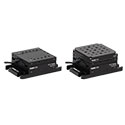 |
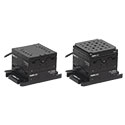 |
 |
 |
|
| Travel | 1" | 25 mm | 50 mm | ||
| Maximum Velocity | 7.0 mm/s | 2.0 mm/s | 50 mm/s | ||
| Possible Axis Configurations |
X, XY | X, XY, XYZ | X, XY, XYZ | ||
| Mounting Surface Size |
3" x 3" | 60 mm x 60 mm | 100 mm x 100 mm | ||
| Additional Details | |||||
| Stepper Motor Stages | ||||||||
|---|---|---|---|---|---|---|---|---|
| Product Family | NRT Series 100 mm Stage |
NRT Series 150 mm Stage |
LTS Series 150 mm Stage |
LTS Series 300 mm Stage |
LTS Series 450 mm Stage |
LTS Series 600 mm Stage |
MLJ250 50 mm Vertical Stage |
|
| Click Photo to Enlarge |
 |
 |
 |
 |
 |
 |
 |
|
| Travel | 100 mm | 150 mm | 150 mm | 300 mm | 450 mm | 600 mm | 50 mm | |
| Maximum Velocity | 30 mm/s | 50 mm/s | 3.0 mm/s | |||||
| Possible Axis Configurations |
X, XY, XYZ | X, XY, XYZ | X, XY | Z | ||||
| Mounting Surface Size |
84 mm x 84 mm | 100 mm x 90 mm | 148 mm x 131 mm | |||||
| Additional Details | ||||||||
DC Servo Motor Stages
Thorlabs offers linear translation stages with removable or integrated DC servo motors. These stages feature low profiles and many can be assembled in multi-axis configurations.
| DC Servo Motor Stages | ||||
|---|---|---|---|---|
| Product Family | MT Series 12 mm Stages |
PT Series 25 mm Stages |
MTS Series 25 mm Stage |
MTS Series 50 mm Stage |
| Click Photo to Enlarge |
 |
 |
 |
 |
| Travel | 12 mm | 25 mm | 25 mm | 50 mm |
| Maximum Velocity | 2.6 mm/s | 2.4 mm/s | ||
| Possible Axis Configurations | X, XY, XYZ | X, XY, XYZ | ||
| Mounting Surface Size |
61 mm x 61 mm | 101.6 mm x 76.2 mm | 43 mm x 43 mm | |
| Additional Details | ||||
| DC Servo Motor Stages | ||||
|---|---|---|---|---|
| Product Family | M30 Series 30 mm Stage |
M30 Series 30 mm Monolithic XY Stage |
M150 Series 150 mm XY Stage |
KVS30 30 mm Vertical Stage |
| Click Photo to Enlarge |
 |
 |
 |
 |
| Travel | 30 mm | 150 mm | 30 mm | |
| Maximum Velocity | 2.4 mm/s | X-Axis: 170 mm/s Y-Axis: 230 mm/s |
8.0 mm/s | |
| Possible Axis Configurations | X, Z | XY, XZ | XY | Z |
| Mounting Surface Size |
115 mm x 115 mm | 272.4 mm x 272.4 mm | 116.2 mm x 116.2 mm | |
| Additional Details | ||||
Direct Drive Stages
These low-profile stages feature integrated brushless DC servo motors for high speed translation with zero backlash. When no power is applied, the platforms of these stages have very little inertia and are virtually free running. Hence these stages may not be suitable for applications where the stage's platform needs to remain in a set position when the power is off. We do not recommend mounting these stages vertically.
| Direct Drive Stages | |||||
|---|---|---|---|---|---|
| Product Family | DDS Series 50 mm Stage |
DDS Series 100 mm Stage |
DDS Series 220 mm Stage |
DDS Series 300 mm Stage |
DDS Series 600 mm Stage |
| Click Photo to Enlarge |
 |
 |
 |
 |
 |
| Travel | 50 mm | 100 mm | 220 mm | 300 mm | 600 mm |
| Maximum Velocity | 500 mm/s | 300 mm/s | 400 mm/s | 400 mm/s | |
| Possible Axis Configurations | X, XY | X, XY | X | X | |
| Mounting Surface Size | 60 mm x 52 mm | 88 mm x 88 mm | 120 mm x 120 mm | ||
| Additional Details | |||||

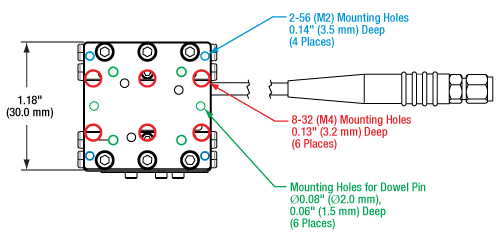
Click for Details
Figure G1.1 PD1(/M) Top Plate Schematic. Dimensions for the metric stage are given in parentheses.
Includes:
- Linear Stage with Integrated Cable, SMC Female Connector
- Two 2-56 (M2) Mounting Screws
- Two 8-32 (M4) Mounting Screws
- Two Ø2 mm Dowel Pins
- Open-Loop Operation Supported
- Provides High-Resolution Positioning
- <5 mrad XY Stacked Orthogonality
- Speeds Up to 3 mm/s when Driven with KIMx01 Controller
- Integrated 1 m (3.3 ft) Cable with SMC Female Connector
- Requires the KIM001, KIM101, PDXC, or PDXC2 Piezo Inertia Controller (Sold Separately Below)
This ORIC® open-loop piezo inertia stage can support loads up to 3 kg, operates with no backlash, and can achieve speeds up to 3 mm/s when driven with a KIMx01 controller. The piezo inertia drive is self-locking when the stage is at rest and no power is supplied to the piezo, making these actuators ideal for set-and-hold applications that require micrometer resolution and long-term alignment stability. See the Specs tab for detailed specifications.
The stage should be placed on a surface with flatness ≤5 µm. If needed, the PD1B(/M), PD1B2(/M), or PD1B3(/M) mounting bases (sold separately below) will provide a flat surface for the stage to reduce stage warping. Along with this, we also offer alternative top plate adapters and a right-angle bracket adapter.
Each stage has an integrated 1.0 m cable; 1.5 m SMC extension cables (Item # PAA101) and male-to-male SMC adapters (Item # T5026) are also available. Please note that, due to the capacitance of the cables, the total length of the control cable should not exceed 2.5 m.
The PD1(/M) stage is compatible with all four of the controllers offered on this page: the KIM001 Single-Channel K-Cube® Piezo Inertia Motor Controller, KIM101 Four-Channel K-Cube Piezo Inertia Motor Controller, the PDXC Piezo Inertia Stage Controller, and the PDXC2 Compact Piezo Inertia Stage Controller. The PDXC2AD female D-sub to male SMC adapter cable is needed to use this stage with the PDXC2 controller. The KIM101 controller must be the 2019 or newer version and revision 010003 or higher firmware. Earlier versions of this controller or those with older firmware will not function properly and may cause failure of the stage and/or the controller. The specifications for this stage were measured using the KIM101 K-Cube Controller (see the Specs tab for details); similar performance is provided by the KIM001 controller. Since the PDXC and PDXC2 controllers operate at higher frequencies but output a lower maximum voltage than the K-Cube controllers, they are capable of driving the PD1(/M) stage at a higher speed with a smaller step size and lower driving force.
Note: During operation, the stage makes a high-pitch noise and may generate some heat. This is normal behavior in the performance of the device and does not indicate a fault condition.

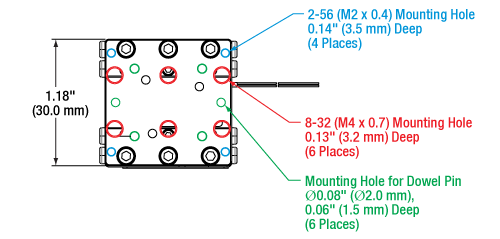
Click for Details
Figure G2.1 PD1V(/M) Top Plate Schematic. Dimensions for the metric stage are given in parentheses.
Includes:
- Linear Stage with Integrated Bare Leads
- Additional 1.0 m (3.3 ft) Bare Lead-to-SMC Cable
- Two 2-56 (M2) Mounting Screws
- Two 8-32 (M4) Mounting Screws
- Two Ø2 mm Dowel Pins
- Vacuum-Compatible Down to 10-6 Torr
- Open-Loop Operation
- Provides High-Resolution Positioning
- Speeds Up to 3 mm/s when Driven with KIMx01 Controller
- Integrated 0.75 m (2.48 ft) Cable with Bare Leads
- Additional 1.0 m (3.3 ft) Bare Lead-to-SMC Cable Included
- Requires the KIM001, KIM101, PDXC, or PDXC2 Piezo Inertia Controller (Sold Separately Below)
This ORIC® open-loop piezo stage can support loads up to 3 kg, operates with no backlash, and can achieve speeds up to 3 mm/s when driven with a KIMx01 controller. The piezo inertia drive is self-locking when the stage is at rest and no power is supplied to the piezo, making the stage ideal for set-and-hold applications that require micrometer resolution and long-term alignment stability. See the Specs tab for detailed specifications.
The stage should be placed on a surface with flatness ≤5 µm. If needed, the PD1B(/M), PD1B2(/M), or PD1B3(/M) mounting bases (sold separately) will provide a flat surface for the stage to reduce stage warping. We also offer the PD1T(/M) and PD1U(/M) top plate adapters for alternative hole patterns and the PD1Z(/M) right-angle bracket adapter for vertical mounting.
This stage is vacuum compatible down to 10-6 Torr. It is recommended that before the unit and any adapter plates are installed in the vacuum chamber, all components are pre-baked in order to remove volatile compounds and moisture from the unit, which could potentially spoil the vacuum. During the pre-bake, the temperature must be limited to 100 °C. If separately baking out mechanical accessories, the temperature can be as high as 150 °C, but the components must cool down to room temperature before mounting on the stage. The stage has an integrated 0.75 m long vacuum-compatible cable with flying leads for connecting the actuator to the vacuum chamber bulkhead. The leads are PTFE-coated, 30 AWG wires; the red lead is positive and the white lead is negative. A 1.0 m dual-core cable with an SMC connector is also included.
The PD1V(/M) stage is compatible with all four of the controllers offered on this page: the KIM001 Single-Channel K-Cube® Piezo Inertia Motor Controller, KIM101 Four-Channel K-Cube Piezo Inertia Motor Controller, the PDXC Piezo Inertia Stage Controller, and the PDXC2 Compact Piezo Inertia Stage Controller. The PDXC2AD female D-sub to male SMC adapter cable is needed to use this stage with the PDXC2 controller. The KIM101 controller must be the 2019 or newer version and revision 010004 or higher firmware. Earlier versions of this controller or those with older firmware will not function properly and may cause failure of the stage and/or the controller. The specifications for this stage were measured using the KIM101 K-Cube Controller (see the Specs tab for details); similar performance is provided by the KIM001 controller. Since the PDXC and PDXC2 controllers operate at higher frequencies but output a lower maximum voltage than the K-Cube controllers, they are capable of driving the PD1V(/M) stage at a higher speed with a smaller step size and lower driving force.
Note: During operation, the stage makes a high-pitch noise and may generate some heat. This is normal behavior in the performance of the device and does not indicate a fault condition.

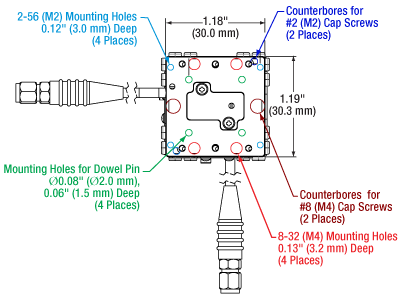
Click for Details
Figure 725A PD1D(/M) Top Plate Schematic. Dimensions for the metric stage are given in parentheses.
Includes:
- Monolithic XY Stage with Integrated Cables, SMC Female Connectors
- Two 2-56 (M2) Mounting Screws
- Two 8-32 (M4) Mounting Screws
- Two Ø2 mm Dowel Pins
- Open-Loop Operation Supported
- Monolithic XY Stage with ≤2 mrad Orthogonality
- Provides High-Resolution Dual-Axis Positioning
- Speeds Up to 3 mm/s when Driven with KIMx01 Controller
- Integrated 1 m (3.3 ft) Cables with SMC Female Connectors
- Requires Two KIM001, One KIM101, One PDXC, or Two PDXC2 Piezo Inertia Controller(s) (Sold Separately Below)
This ORIC® open-loop, piezo inertia, monolithic XY stage can support loads up to 3 kg, operates with no backlash, and can achieve speeds up to 3 mm/s when driven with a KIMx01 controller. The piezo inertia drive is self-locking when the stage is at rest and no power is supplied to the piezo, making these actuators ideal for set-and-hold applications that require micrometer resolution and long-term alignment stability. See the Specs tab for detailed specifications. Note that the PD1D(/M) stage is monolithic and cannot be disassembled into two single-axis stages.
The stage should be placed on a surface with flatness ≤5 µm. If needed, the PD1B(/M), PD1B2(/M), or PD1B3(/M) mounting bases (sold separately below) will provide a flat surface for the stage to reduce stage warping. Along with this, we also offer alternative top plate adapters and a right-angle bracket adapter.
Each stage has integrated 1.0 m cables; 1.5 m SMC extension cables (Item # PAA101) and male-to-male SMC adapters (Item # T5026) are also available. Please note that, due to the capacitance of the cables, the total length of the control cable should not exceed 2.5 m.
The PD1D(/M) stage is compatible with all three of the controllers offered on this page: the KIM001 Single-Channel
Note: During operation, the stage makes a high-pitch noise and may generate some heat. This is normal behavior in the performance of the device and does not indicate a fault condition.

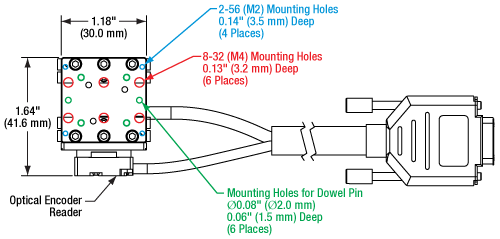
Click for Details
Figure G4.1 PDX1(/M) Top Plate Schematic. Dimensions for the metric stage are given in parentheses.
Includes:
- Linear Stage with Integrated Cable, D-Sub Female Connector
- Two 2-56 (M2) Mounting Screws
- Two 8-32 (M4) Mounting Screws
- Three M1.4 Cap Screws
- Two Ø2 mm Dowel Pins
- Individual Test Data Certificate
- Open- and Closed-Loop Operation Supported
- Optical Encoder Provides Resolution Up to 10 nm
- <5 mrad XY Stacked Orthogonality
- Moves at a Speed of Up to 20 mm/s
- Integrated 1.5 m (4.9 ft) Cable with D-Sub Female Connector
- Requires the PDXC or PDXC2 Piezo Inertia Controller (Sold Separately Below)
- Each Stage Individually Tested and Shipped with Test Data Certificate
This ORIC® piezo inertia stage with an optical encoder is able to operate in both open- and closed-loop modes, can support loads up to 3 kg, and operate at speeds up to 20 mm/s with no backlash. The piezo inertia drive is self-locking when the stage is at rest and no power is supplied to the piezo, making these actuators ideal for set-and-hold applications that require nanometer resolution and long-term alignment stability. See the Specs tab for detailed specifications.
After each stage is manufactured, the pitch and yaw of the stage are tested. This ensures that each stage meets the stated specifications over the full translation range of the stage. A summary of the test results is provided on a data sheet that ships with each stage. A sample data sheet can be viewed here.
The stage should be placed on a surface with flatness ≤5 µm. If needed, the PD1B(/M), PD1B2(/M), or PD1B3(/M) mounting bases (sold separately below) will provide a flat surface for the stage to reduce stage warping. Along with this, we also offer alternative top plate adapters and a right-angle bracket adapter.
Each stage has an integrated 1.5 m cable; 3 m (118.1") extension cables (Item # PDXCE) are also available. Please note that, due to the capacitance of the cables, do not use cables longer than 4.5 m in total.
Compatible Controllers: The PDX1(/M) stage is only compatible with the PDXC and PDXC2 controllers, and is not compatible with the KIM001 and KIM101 controllers sold on this page.
Note: During operation, the stage makes a high-pitch noise and may generate some heat. This is normal behavior in the performance of the device and does not indicate a fault condition.

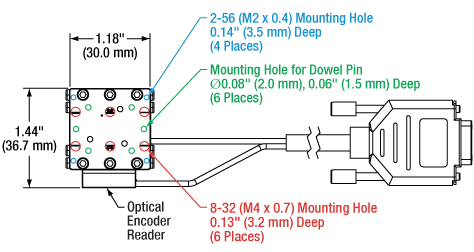
Click for Details
Figure G5.1 PDX1A(/M) Top Plate Schematic. Dimensions for the metric stage are given in parentheses.
Includes:
- Linear Stage with Integrated Cable, D-Sub Female Connector
- Two 2-56 (M2 x 0.4) Mounting Screws
- Two Ø2 mm Dowel Pins
- Individual Test Data Certificate
- Open- and Closed-Loop Operation Supported
- Low-Profile Design: 1.44" x 1.28" x 0.45" (36.7 mm x 32.5 mm x 11.5 mm)
- Optical Encoder Provides Resolution Up to 12.5 nm
- <5 mrad XY Stacked Orthogonality
- Typical Movement Speeds Up to 10 mm/s
- Integrated 1.5 m (4.9 ft) Cable with 15-Pin D-Sub Female Connector
- Requires the PDXC or PDXC2 Piezo Inertia Controller (Sold Separately Below)
- Each Stage Individually Tested and Shipped with Test Data Certificate
The PDX1A(/M) Low-Profile ORIC® Piezo Inertia Stage with an Optical Encoder is designed to operate in open- and closed-loop mode, can support loads up to 3 kg, and operate at speeds up to 10 mm/s with no backlash. The piezo inertia drive is self-locking when the stage is at rest and no power is supplied to the piezo, making these actuators ideal for set-and-hold applications that require nanometer resolution and long-term alignment stability. See the Specs tab for detailed specifications. The PDX1A(/M) stage has a lower profile format compared to the PDX1(/M) stage, with the PDX1A(/M) being 1.44" (36.7 mm) long and 0.45" (11.5 mm) tall, whereas the PDX1(/M) is 1.64" (41.6 mm) long and 0.59" (15.0 mm) tall.
After each stage is manufactured, the pitch and yaw of the stage are tested. This ensures that each stage meets the stated specifications over the full translation range of the stage. A summary of the test results is provided on a data sheet that ships with each stage. A sample data sheet can be viewed here. The sample data was taken for PDX1AV(/M); however, PDX1AV(/M) and PDX1A(/M) have the same performance specifications.
The stage should be placed on a surface with flatness ≤5 µm. If needed, the PD1B(/M), PD1B2(/M), or PD1B3(/M) mounting bases (sold separately below) will provide a flat surface for the stage to reduce stage warping. Along with this, we also offer alternative top plate adapters and a right-angle bracket adapter.
Each stage has an integrated 1.5 m cable; 3 m (118.1") extension cables (Item # PDXCE) are also available. Please note that, due to the capacitance of the cables, do not use cables longer than 4.5 m in total.
Compatible Controllers: The PDX1A(/M) stage is only compatible with the PDXC and PDXC2 controllers and is not compatible with the KIM001 and KIM101 controllers sold on this page.
Note: During operation, the stage makes a high-pitch noise and may generate some heat. This is normal behavior in the performance of the device and does not indicate a fault condition.

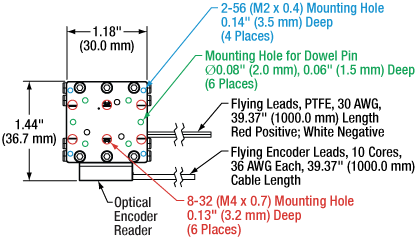
Click for Details
Figure G6.1 The mounting features for the PDX1AV(/M) are identical to the PDX1A(/M) stage sold above. Dimensions for the metric stage are given in parentheses.
Includes:
- Linear Stage with Integrated Flying Leads and Flying Encoder Leads
- Additional 1.0 m (3.3 ft) Bare Lead-to-15-Pin D-SUB Female Cable
- Two 2-56 (M2 x 0.4) Mounting Screws
- Two Ø2 mm Dowel Pins
- Individual Test Data Certificate
- Vacuum-Compatible Down to 10-6 Torr
- Open- and Closed-Loop Operation
- Low Profile Design: 1.44" x 1.28" x 0.45" (36.7 mm x 32.5 mm x 11.5 mm)
- Optical Encoder Provides Resolution Up to 12.5 nm
- <5 mrad XY Stacked Orthogonality
- Typical Movement Speeds Up to 10 mm/s
- Integrated 1.0 m (3.3 ft) Cable with Flying Leads
- Additional 1.0 m (3.3 ft) Bare Lead-to-15-Pin D-Sub Cable Included
- Requires the PDXC or PDXC2 Piezo Inertia Controller (Sold Separately Below)
- Each Stage Individually Tested and Shipped with Test Data Certificate
The PDX1AV(/M) Low-Profile, Vacuum-Compatible ORIC® Piezo Inertia Stage with an Optical Encoder is a vacuum-compatible version of the PDX1A(/M) low-profile piezo inerta stage. This stage is designed to support loads up to 3 kg, operate with no backlash, and achieve typical speeds up to 10 mm/s. The piezo inertia drive is self-locking when the stage is at rest and no power is supplied to the piezo, making the stage ideal for set-and-hold applications that require micrometer resolution and long-term alignment stability. See the Specs tab for detailed specifications.
After each stage is manufactured, the pitch and yaw of the stage are tested. This ensures that each stage meets the stated specifications over the full translation range of the stage. A summary of the test results is provided on a data sheet that ships with each stage. A sample data sheet can be viewed here.
The stage should be placed on a surface with flatness ≤5 µm. If needed, the PD1B(/M), PD1B2(/M), or PD1B3(/M) mounting bases (sold separately) will provide a flat surface for the stage to reduce stage warping. We also offer the PD1T(/M) and PD1U(/M) top plate adapters for alternative hole patterns and the PD1Z(/M) right-angle bracket adapter for vertical mounting.
This stage is vacuum compatible down to 10-6 Torr. It is recommended that before the unit and any adapter plates are installed in the vacuum chamber, all components are pre-baked in order to remove volatile compounds and moisture from the unit, which could potentially spoil the vacuum. During the pre-bake, the temperature must be limited to 100 °C. If separately baking out mechanical accessories, the temperature can be as high as 150 °C, but the components must cool down to room temperature before mounting them on the stage.
Each stage has two integrated 1.0 m long vacuum-compatible flying lead cables for connecting the actuator and the encoder to the vacuum chamber bulkhead. The leads to connect the actuator are PTFE-coated, 30 AWG wires; the red lead is positive and the white lead is negative. The cable to connect the encoder consists of 10 flying leads, each 36 AWG.
A 1.0 m cored cable with flying leads on one end and a 15-pin D-Sub Female connector on the other is also included to aid in connection to the PDXC or PDXC2 controllers outside of the vacuum system. See the Pin Diagrams tab for a full pin description and instructions on connecting the stage to the controllers. Customers wishing to wire the stage to other systems should consult the colored encoder wire diagram in the Pin Diagrams tab to ensure proper electrical connection.
For additional cable length, the PDXCE extension cable, with a length of 3.0 m (118.1"), is available below. Due to the capacitance of the cables, do not use cables longer than 5.0 m in total.
Compatible Controllers: The PDX1AV(/M) stage is only compatible with the PDXC and PDXC2 controllers, and is not compatible with the KIM001 and KIM101 controllers sold on this page.
Note: During operation, the stage makes a high-pitch noise and may generate some heat. This is normal behavior in the performance of the device and does not indicate a fault condition.

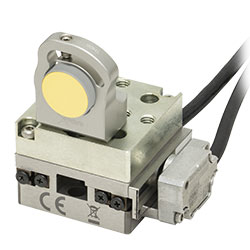
Click to Enlarge
Figure 804C PF05-03-M01 Mirror in POLARIS-B05S Fixed Optic Mount on PD1U Adapter Plate with PDX1 Stage
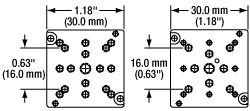
Click for Details
Figure 804A PD1T and PD1T/M Adapter Plate Schematics
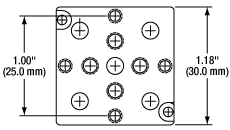
Click for Details
Figure 804B PD1U Adapter Plate Schematic. Dimensions for the metric adapter plate are given in parentheses.
- Provide Different Mounting Hole Patterns
- Match 30 mm x 30 mm Footprint of Piezo Stage
- Each Adapter Includes Two 2-56 (M2 x 0.4) Mounting Screws and Two Ø2 mm Dowel Pins
These adapter plates provide alternative mounting holes for the stages above. Each adapter matches the footprint of the stage and can be secured to the top or bottom of the stage using the two included 2-56 (M2 x 0.4) cap screws in the mounting counterbores near the corners.
The PD1T imperial adapter plate features a central 8-32 tapped hole and sixteen 4-40 tapped holes, four of which are spaced for 16 mm cage systems. The metric version features a central M4 x 0.7 tapped hole, ten M2 x 0.4 mounting taps, four
The PD1U imperial adapter plate features four 6-32 and four 8-32 tapped holes in a cross pattern; the metric version features eight M4 x 0.7 tapped holes in the same layout. The bottom surface features five #8 (M4) counterbores, as well as four Ø2 mm dowel pin holes for alignment. See Figure 804B for more details.

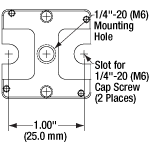
Click for Details
Figure G8.2 PD1B2(/M) Mounting Adapter Schematic. Dimensions for the metric stage are given in parentheses.
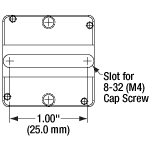
Click for Details
Figure G8.1 PD1B(/M) Mounting Adapter Schematic. Dimensions for the metric stage are given in parentheses.
- Provide Flat Surface for Mounting PD1(/M), PD1V(/M), PDX1(/M), PDX1A(/M), PDX1AV(/M), or UDX1(/M) Stages
- Two Versions Available:
- PD1B(/M): #8 (M4) Mounting Slot
- PD1B2(/M): 1/4" (M6) Mounting Slots and 1/4"-20 (M6 x 1.0) Threaded Mounting Hole
- Reduces Stage Warping When Mounting to Table or Breadboard
These adapters provide a flat surface for mounting the stages above. The PD1B(/M) adapter features a #8 (M4) mounting slot and the PD1B2(/M) adapter features 1/4" (M6) mounting slots and a 1/4"-20 (M6 x 1.0) threaded mounting hole. If the stage is mounted on a surface with >5 µm flatness (as with most breadboards and optical tables), the velocity variation and pitch/yaw of the stage may suffer due to the stage warping. Mounting the stage on these adapters drastically reduces the amount the stage warps when mounted on a table or breadboard with insufficient flatness.
The stage can be mounted to the adapter using two 2-56 (M2) screws near the corners with a maximum of 0.35 N·m torque. Alternatively, two 8-32 (M4) screws can be used on either end of the stage with up to 0.55 N·m torque. To mount the PD1B(/M) to a breadboard, two SH8S025 (SH4MS06) 8-32 (M4) cap screws and two W8S038 #8 (M4) washers can be used. To mount the PD1B2(/M) to a breadboard, two SH25S038 (SH6MS10) 1/4"-20 (M6) and two W25S050 1/4" (M6) washers can be used.

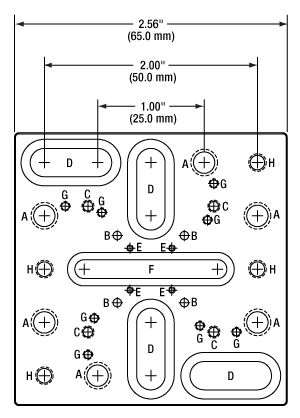
Click for Details
Figure 763B Mechanical Drawing for the PD1B3(/M) Adapter Plate. See Table 763C for descriptions of the hole labels. Dimensions for the metric version of the adapter plate are given in parentheses.
- Provide Flat Surface for Mounting ORIC Stages
- Passivated Stainless Steel Construction
- Reduces Stage Warping When Mounting to Table or Breadboard
- Dimensions (L x W x H): (65.0 mm x 65.0 mm x 10.0 mm)
Thorlabs' PD1B3(/M) Universal Adapter Plate provides a flat surface (flatness ≤5 µm) for mounting any of the ORIC piezo stages. Mounting holes are labeled in Figure 763B corresponding to Table 763C. The four 4-40 threaded holes are 30 mm cage system compatible, and two 1/4"-20 (M6 x 1.0) screws are included for mounting to breadboards.
If the stage is mounted on a surface with >5 µm flatness (as with most breadboards and optical tables), the velocity variation and pitch/yaw of the stage may suffer due to the stage warping. Mounting the stage on the adapter drastically reduces the amount the stage warps when mounted on a table or breadboard with insufficient flatness.
| Table 763C Mounting Holes | ||||
|---|---|---|---|---|
| Labela | Holes/Slots Patternb | Spacingb (Stage Compatibility) | Threading Depth | Places |
| A | 1/4"-20 (M6 x 1.0) | 1" x 2" (25 x 50 mm) | Through | 6 |
| B | Ø2 mm Dowel Pin Holes |
16 x 16 mm (Item #s PDXZ1(/M), PD1(/M), PD1V(/M), PD1D(/M), PDX1(/M), PDX1A(/M), PDX1AV(/M), PD3(/M), PDX3(/M), PDR1C(/M), UDX1(/M)) | 1.5 mm | 4 |
| C | 4-40 | 30 x 30 mm (Item #s PDR1(/M), PDR1V(/M)) | 3.5 mm | 4 |
| D | 1/4" (M6) Counterbored Slot | 1" to 2" (25 to 50 mm) | N/A | 4 |
| E | 00-90 (M1.2 x 0.25) | 10 x 10 mm (Item #s PD2(/M), PDX2(/M), PDX4(/M)) | 3 mm | 4 |
| F | #8 (M4) Counterbored Slot | 1.25" (31.25 mm) | N/A | 1 |
| G | 2-56 (M2 x 0.4) | 27.0 x 23.4 mm (Item #s PDXZ1(/M), PD1(/M), PD1V(/M), PD1D(/M), PDX1(/M), PDX1A(/M), PDX1AV(/M), PDR1C(/M), UDX1(/M)) / 40.8 x 30 mm |
7 mm | 8 |
| H | 8-32 (M4 x 0.7) | 1" (25 mm) (Item # UDX1(/M)) 2" (50 mm) (Item #s PD3(/M), PDX3(/M)) / 2" x 2" (50 x 50 mm) (Item # PDXR1(/M)) |
7.8 mm | 4 |

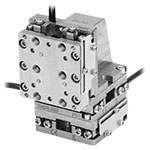
Click to Enlarge
Figure 805B Three PD1(/M) Stages can be mounted in an XYZ configuration using the PD1Z(/M) adapter.
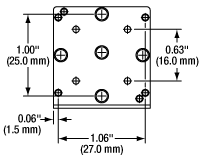
Click for Details
Figure 805A Schematic of Right-Angle Bracket's Vertical Face. Dimensions for the metric bracket are given in parentheses.
- Connects Single-Axis Stages for 2-Axis or 3-Axis Configuration
- Mounts Stage at 90° for Vertical or Horizontal Translation
- Two 2-56 (M2 x 0.4) Mounting Screws Included
The PD1Z(/M) right-angle bracket allows the user to mount the single-axis stages above at 90° for Z-axis, XZ, or XYZ applications. The bracket can be secured to the top plate of a stage using two 2-56 (M2 x 0.4) cap screws in the mounting counterbores near the corners. The vertical stage can be mounted on the bracket using the two included 2-56
The piezo stage can be mounted on the right-angle bracket for either vertical or horizontal translation. Using the #8 (M4) counterbores on the bracket, the single-axis stage can be secured to a PD1B(/M), PD1B2(/M), or PD3B(/M) adapter for a Z-axis configuration that can be mounted to an optical table or breadboard.
Note that in an XYZ configuration, the locking plate of the bottom stage may interfere with the translation range of the vertical stage. Simply remove the locking plate to achieve the full range of translation in all three dimensions.
Note: When mounted vertically, long term usage (>3 billion steps) may cause creep of the rails, leading to decreased travel range. To avoid this, return the stage to a horizontal position and run it back and forth over the full range several times after approximately 1 billion steps in a vertical orientation. Mounting the PD1D(/M) monolithic stage vertically is not recommended because the rails for one axis will experience a lateral force that may influence the angular error and even reduce the lifespan of the rail.

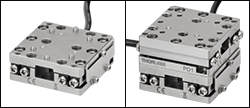
Click for Details
Figure 753A PD1P1 Dowel Pins fit into the mounting holes of most ORIC® Stages, as shown here in the PD1 Stage.
- Ø2 mm, 3 mm Long Dowel Pins
- Corrosion-Resistant Stainless Steel
- Sold in Packs of 20
The PD1P1 Dowel Pins are 2 mm in diameter and are 3 mm long. They serve as replacements for the dowel pins that are included with Thorlabs' 4.5 mm Vertical, 20 mm, 50 mm, Rotating, and Vacuum-Compatible ORIC® Stages. Composed of stainless steel, the dowel pins are corrosion-resistant.
The dowel pins are sold in packs of 20.

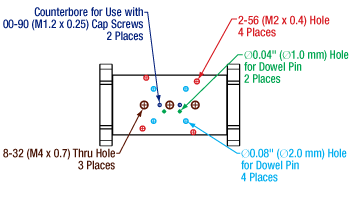
Click for Details
Figure G12.1 Mounting Hole Pattern for the XPCM1(/M) Stage to Cage Mount. Dimensions and threads for the metric part are given in parentheses.
- XPCM1(/M) Stage to 30 mm Cage System Mount
- Directly Mount a PD1(/M), PD1V(/M), PDX1A(/M) or PDX1AV(/M) 20 mm Linear Translation Stage
- Accepts a PD2 Series 5 mm Translation Stage Mounted to PD2U(/M) Adapter Plate
- Snap-On Clamping Flexure Mechanism for Easy Installation in and Removal from Cage Systems
- PD1FM Ø1" Optic Mount:
- Compatible with All ORIC 20 mm Linear Translation Stages
- Centers Optic in 30 mm Cage System when Combined with a PD1(/M), PD1V(/M), PDX1A(/M), or PDX1AV(/M) Stage and the XPCM1(/M) Adapter
- Can be Mounted Parallel or Perpendicular to the Stage Translation Direction
- SM1-Threaded Optic Bore with Included POLARIS-SM1RR Retaining Ring
A PD1(/M), PD1V(/M), PDX1A(/M), or PDX1AV(/M) Piezoelectric Inertia Stage can be combined with the XPCM1(/M) Stage to 30 mm Cage System Mount and PD1FM Ø1" Optic Mount to provide z- or x-axis translation for an optic vertically centered in a 30 mm Cage System.
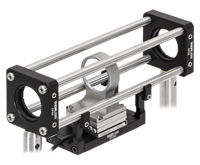
Click to Enlarge
Figure G12.2 An optic mounted in a 30 mm cage system via the XPCM1 mount, PD1 stage, and PD1FM optic mount.
XPCM1(/M) Stage to Cage Mount
The XPCM1(/M) Stage to Cage Mount is designed to integrate certain 20 mm piezoelectric inertia stages (Item #s PD1(/M), PD1V(/M), PDX1A(/M), PDX1AV(/M)), or PD2 Series Piezoelectric Inertia Stage into a 30 mm Cage System. It is made from anodized aluminum and features four snap-on tabs for easy installation and removal; a 5/64" (2.0 mm) hex setscrew on each tab can be tightened to secure the mount in place. The mount features a hole pattern (see Figure G12.1) that permits several options for mounting a piezoelectric inertia stage or adapter plate. Four 2-56 (M2 x 0.4) mounting holes and four Ø0.08" (2.0 mm) dowel holes enable the compatible 20 mm stages given above to be directly mounted to the surface. Two #00 (M1.2) counterbores and two Ø0.04" (1.0 mm) dowel holes allow for compatibility with the PD2U(/M) adapter plate, permitting the mounting of Thorlabs' PD2 series 5 mm linear translation stages. Three 8-32 (M4 x 0.7) mounting thru holes down the center line of the stage can be used for post mounting of the XPCM1(/M) mount, or as another option for securing a 20 mm stage or PD2U(/M) adapter plate.
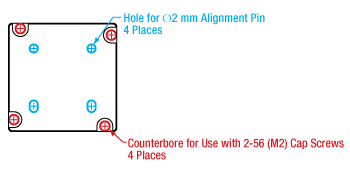
Click for Details
Figure G12.3 Mounting Holes on the PD1FM Optic Mount
PD1FM Ø1" Optic Mount
The PD1FM Fixed Optic Mount is designed to mount a Ø1" optic along the optical axis of a 30 mm cage system when used with a compatible 20 mm piezoelectric inertia stage (Item #s PD1(/M), PD1V(/M), PDX1A(/M), or PDX1AV(/M)) and XPCM1(/M) mount, as shown in Figure G12.2. It features two pairs of #2 (M2) counterbored mounting holes and four 0.07" (1.8 mm) deep alignment pin holes for mounting at 0 or 90° to the translation axis of the stage, enabling z- and x-axis adjustment; two Ø2 mm alignment pins are included with the PD1FM mount. When incorporated into a 30 mm cage system using a compatible 20 mm linear stage mounted on the XPCM1(/M) stage to cage mount, the full 20 mm translation range of the stage is achievable in the z-direction while the cutouts in the sides of the PD1FM mount provide clearance for ±3 mm of movement along the x-axis. Note that the XPCM1(/M) cage mount and PD1FM Ø1" optic mount can be used with the PDX1(/M) stage but the optic will not be centered along the cage system's optical axis. The PD1D(/M) XY stage cannot be used with the cage mount and optic mount at the same time.
The mount is of stainless steel construction with a central optic bore that is SM1 (1.035"-40) threaded; it has a thread depth of 0.36" (9.1 mm) that can support optics up to 0.28" (7.1 mm) thick. Mounted optics are secured by the included POLARIS-SM1RR retaining ring.
Note: When mounting a 20 mm linear piezoelectric inertia stage to a surface with >5 µm flatness, such as the XPCM1(/M) stage to cage mount, the mounting torque may need to be reduced from the recommended values (see the Overview tab) in order for the velocity variation and pitch/yaw of the stage to meet the specifications for the stage.

| Table 675A Key Specificationsa | ||
|---|---|---|
| Item # | KIM001 | KIM101 |
| Piezoelectric Outputs (SMC Male) | One | Four |
| Piezo Output Voltage | 85 to 125 VDC | 85 to 125 VDC per Channel |
| Top Panel Controls | Scroll Wheel | Dual-Axis Joystick |
| External Input (SMA Female) |
±10 V ± 2% | |
| Input Power | +15 VDC @ 2 A | |
| Housing Dimensionsb |
60.0 mm x 60.0 mm x 47.0 mm (2.36" x 2.36" x 1.85") |
121.0 mm x 60.0 mm x 47.0 mm (4.76" x 2.36" x 1.85") |
| Compatible Software | Kinesis | |
| Compatible Piezo Inertia Stagesc |
5 mm Linear Stage, 20 mm Linear Stages, 50 mm Linear Stage, & Rotation Stages |
|
- Compact Footprints
- Adjustable Voltage Output from 85 V to 125 V
- Single-Channel and Four-Channel Versions Available
- Standalone Operation via Top Panel Controls and Display or PC Control via USB Plug and Play
- See Table 675A for Compatible Stages
These compact K-Cube® Controllers provide easy manual and PC control of our piezo inertia stages that use SMC connectors, piezo inertia actuators, and optic mounts. They are also compatible with our PD2(/M) 5 mm or PD3(/M) 50 mm linear stages when used with a PD2AD adapter cable (sold separately). The controllers feature adjustable voltage output from 85 V to 125 V. The top panel display screen enables operation as soon as the unit is turned on, without the need for connection to a PC. Alternatively, both controllers have USB connectivity that provides 'Plug-and-Play' PC-controlled operation with our Kinesis software package (included).
These units have small footprints and may be mounted directly to the optical table using the 1/4" (M6) counterbored slots in the base plate. Their compact size allows these controllers to be positioned close to the motorized system for added convenience when manually adjusting motor positions using the top panel controls. Tabletop operation also allows minimal drive cable lengths for easier cable management.
KIM001 Single-Channel Controller
This single-channel piezo inertia controller provides a voltage output for a single piezo inertia stage or actuator. The top panel features a spring-loaded scroll wheel for driving the stage or actuator as well as selecting menu options.
KIM101 Four-Channel Controller
This four-channel controller features four SMC outputs to drive piezo inertia devices. The channels can be controlled independently or simultaneously in pairs using the dual-axis joystick on the controller's top panel. The controller can be configured to operate up to four PD series piezo inertia stages, up to four PIA series piezo inertia actuators, or up to two PIM series piezo inertia optic mounts; one KIM101 can only concurrently drive devices that use the same "Select Stage" configuration in the controller's menu options (see the manuals for more details).
For more information, please see the full web presentation.
Operation
Set the stage configuration on the KIM001 or KIM101 controller to "PD(R)" before driving this stage. Select the "Select Stage" option, change it from "PIA" to "PD(R)", and then restart the controller. The display will show "Stage is PD(R)" and the configuration will be changed to drive the ORIC PD Series stage. For additional front panel configuration details, please see the KIM001 or KIM101 controller manuals by clicking the red Docs icons (![]() ) below. These drivers have an internal sawtooth voltage signal generator capable of sending sub-millisecond pulses (steps) with controllable amplitudes from 85 V to 125 V.
) below. These drivers have an internal sawtooth voltage signal generator capable of sending sub-millisecond pulses (steps) with controllable amplitudes from 85 V to 125 V.
Power Supply
The KIM001 and KIM101 Motor Controllers do not ship with a power supply. The compatible KPS201 Power Supply is sold separately below.
Note: Due to the nature of its design, and its non-linear high frequency switching, the KIM001 and KIM001 units are not compatible with the KEH3 or KEH6 hubs. Only use the KPS201 power supply unit. These controllers are also not compatible with the PDX1(/M), PDX1A(/M), or PDX1AV(/M) stages. Compatibility with the PD2(/M) 5 mm and PD3(/M) 50 mm stages require the PD2AD adapter cable.

- Power Supply Compatible with KIM001 and KIM101 Motor Controllers
- Universal Input: 100 - 240 VAC
- Region-Specific Adapter Plug Shipped with Power Supply
The KPS201 power supply outputs +15 VDC at up to 2.66 A and can power a single K-Cube® or T-Cube™ with a 3.5 mm jack. It plugs into a standard wall outlet. One region-specific plug adapter, selectable at checkout, is included with each power supply.

| Key Specificationsa | ||
|---|---|---|
| SMC Port | Number of Ports | Two |
| Voltage | 0 to 40 V | |
| Frequency | 20 kHz Max | |
| D-Sub Port | Number of Ports | One |
| Voltage | -10 to 50 V | |
| Frequency | 20 kHz Max | |
| Max Current Limit | 10 A | |
| Front USB | Type A, USB Host 2.0 | |
| Back USB | Type B, USB Device 2.0 | |
| Voltage of Analog In/Out | -10 to 10 V, ±2% | |
| Voltage of Trigger In/Out | 0 to 5 V, TTL | |
| Input Power | 100 - 240 VAC, 50 - 60 Hz | |
- Controller for ORIC Piezo Inertia Linear Stages, PDXZ1(/M) Vertical Stage, and both PDR1C(/M) and PDXR1(/M) Rotation Stages
- Supports Both Open- and Closed-Loop Operation
- SMC and 15-Pin D-Sub Ports Available
This controller is designed to control our ORIC piezo-inertia-driven linear stages, PDXZ1(/M) vertical stage, and both PDR1C(/M) and PDXR1(/M) rotation stages. It offers two channels that support open-loop stage control using SMC outputs and one channel that can provide open- or closed-loop stage control using a 15-pin D-sub output. If a longer connection is required for ORIC stages with a D-Sub connector, the PDXCE Extension Cable can be used (sold separately below).
Embedded software allows this unit to be fully controlled using the buttons, LCD display, and knob on the front panel. Alternatively, built-in external trigger modes support single-channel operation. By connecting multiple controllers together, multi-channel operation in D-sub mode such as a raster scan is possible. Users can select the output port(s), switch between open-loop and closed-loop modes, and perform homing and encoder calibration without being connected to a PC. In addition to these on-unit controls, USB connectivity provides simple PC-control with our available software platform.
The unit comes with a compatible region-specific power cord. For all applications, use an IEC320 compatible power cord fitted with a plug appropriate for your particular power socket. Ensure the line voltage rating marked on the rear panel agrees with your local power supply.
For more information, please see our full web presentation.

| Key Specificationsa | ||
|---|---|---|
| Performance Specificationsa | ||
| D-sub Port | Number of Ports | One |
| Voltage | 0 to 56 V | |
| Frequency | 20 kHz Max | |
| Max Current Limit | 10 A | |
| Front USB | Type A, USB HID Host | |
| Back USB | Type B, USB Device 2.0 | |
| I/O Port | Voltage of Analog In/Out | -10 to 10 V, ±2% |
| Voltage of Trigger In/Out | 0 to 5 V, TTL | |
| Ethernet PC Communication | One RJ-45 Port | |
| Dimensions (L x W x H) | 115.2 mm x 150.0 mm x 48.5 mm (4.54” x 5.91” x 1.91”) |
|
| Weight | 0.53 kg | |
| Input Power | 12 V, 3 A DAC | |
- Controller for ORIC Piezo Inertia Linear Stages, PDXZ1(/M) Vertical Stage, and both PDR1C(/M) and PDXR1(/M) Rotation Stages
- Compact Design and PC Control with Kinesis® Software
- Supports Both Open- and Closed-Loop Operation
- Energy Efficient Switch Amplifier Circuit Outputs Peak Current of 10 A
- Configurable High Speed Communication Interfaces: USB 2.0, Gigabit Ethernet, Digital I/0, Analog I/0
- 800 Hz to 20 kHz Pulse Rate Range
The PDXC2 compact controller is designed for our ORIC piezo-inertia-driven linear stages, PDXZ1(/M) vertical stage, and both PDR1C(/M) and PDXR1(/M) rotation stages. It features one channel that supports open- or closed-loop stage control using a 15-pin D-sub output. The PDXC2AD D-sub to SMC adapter cable (sold below) can be used to operate stages with an SMC connection in open-loop mode.
The PDXC2 controller is connected to PC by either the USB or ethernet ports on the back panel of the controller. All the operating parameters and operations, such as switching between open- and closed-loop modes, performing homing operation, and parameter optimization are controlled by PC with the Kinesis® software (available for download on the Kinesis Software tab). Settings such as trigger modes and movement parameters can be configured for operations such as raster scans. Calibration for specific ORIC stages with encoders (Item #s PDX1(/M), PDX1A(/M), PDX1AV(/M), and PDXR1(/M) only) is performed with the PDXC2 Calibration Tool found on the Motion Control Software page. Please see the user manual for details. Command-line control is also possible through the USB and RS-232 ports.
The PDXC2 unit is powered by the included DS12 12 VDC power adapter, which operates at an input voltage of 100 - 240 VAC and ships with a region-specific AC cable. For all applications, use an IEC320 compatible power cord fitted with a plug appropriate for your particular power socket. Make sure that the line voltage rating marked on the power adapter agrees with your local power supply.
For more information, please see our full web presentation.

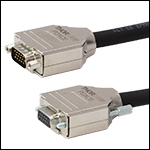
Click to Enlarge
Figure 759B DB15 Male to DB15 Female
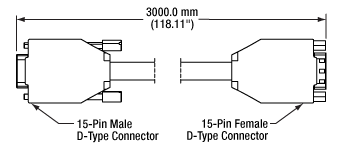
Click to Enlarge
Figure 759A Mechanical Drawing
- Connects Female D-Sub Connector on a PDXZ1(/M), PD2(/M), PDX2(/M), PDX4(/M), PDX1(/M), PDX1A(/M), PDX1AV(/M), PD3(/M), PDX3(/M), or PDXR1(/M) Stage to PDXC or PDXC2 Piezo Inertia Stage Controller
- 3000.0 mm (118.11") of Extra Length
The PDXCE extension cable provides 3000.0 mm (118.11") of extra cord length, if needed, when connecting ORIC stages with a Female D-Sub Connector to the PDXC or PDXC2 ORIC Inertia Stage Controllers. Due to the capacitance of the cables, each stage has a recommended maximum cable length. Please check individual stage specifications before adding extension cables.

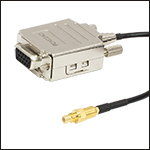
Click for Details
Figure 758B DB15 Female to SMC Male

Click for Details
Figure 758A Mechanical Drawing
- 1 m Long D-Sub to SMC Adapter Cable
- Connects the PDXC2 Controller's D-sub port to the PD1(/M), PD1V(/M), PD1D(/M), or PDR1C(/M) Stage's SMC Connection
The PDXC2AD adapter cable has a female 15 pin D-sub connection and a male SMC connection. The cable adapts the PDXC2 controller's male 15-pin D-sub port to the SMC termination of the PD1(/M), PD1D(/M), PD1V(/M) 20 mm stages, or PDR1C(/M).
 Products Home
Products Home















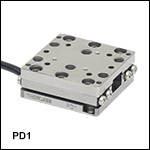
 Zoom
Zoom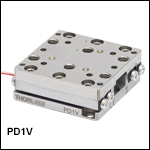

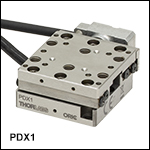





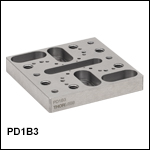
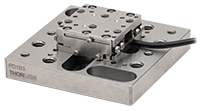
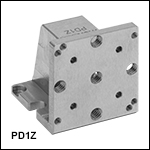
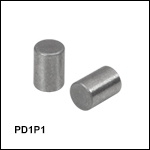
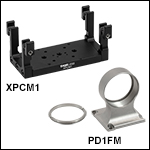
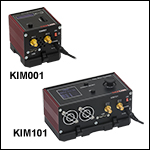
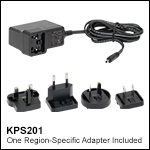
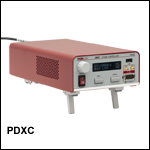
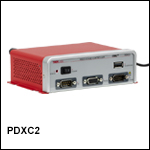
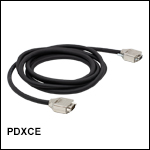
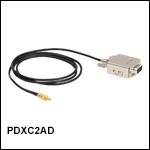
 20 mm Travel, Piezo Inertia Motor
20 mm Travel, Piezo Inertia Motor